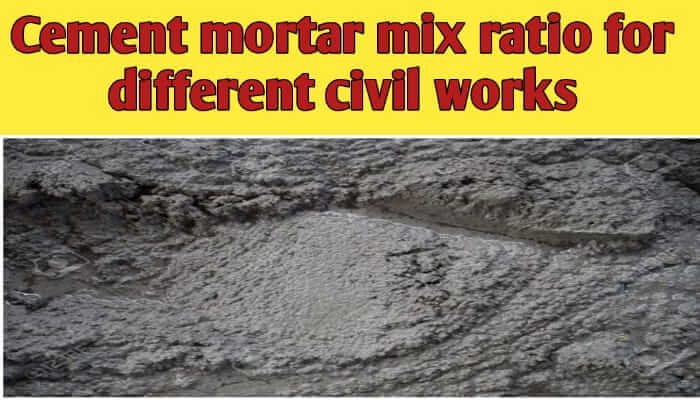The cement mortar mix ratio depends on the type of construction and the strength requirements of the mortar. Generally, the cement mortar should have a mixing ratio of 1:2 to 1:6 (cement: sand) by volume. Cement Mortar Mix Ratio: Brick masonry, 1:6 or 1:5 ; Plastering, 1:5 or 1:4 ; Tile flooring, 1:2 ; Beam or Lintel, 1:2:4 ; Column Concrete, 1:1:2.

The amount of cement is mixed with the desired proportion of sand or fine aggregates with water to produce a good, adhesive paste that adheres well to many construction works such as plastering walls and ceiling, brick masonry, cement grouting, slab concrete, tile flooring, cement slurry, pointing work, laying of fire bricks, repair works etc.
Cement mortar adheres well to stone masonry, increasing strength and increasing durability. Lime can sometimes be added in the proportion 1 part lime to 5 parts cement in order to improve the consistency or workability of the paste. Fine cement-sand paste can be made by mixing 1 part cement with 1 to 6 parts sand mixed with water.
Here are some common cement mortar mix ratios for different civil works:
- General Masonry Work: For general masonry work like brickwork, block work and stone masonry, a mix ratio of 1:4 to 1:6 (cement to sand) is usually used. A mix ratio of 1:6 is used for 9″ brick wall, and a mix ratio of 1:4 is used for 4″ or half brick wall.
- Plastering: For plastering of walls and ceiling, a mix ratio of 1:3 to 1:6 (cement to sand) is commonly used. A mix ratio of 1:5 is used for external wall plastering, a mix ratio of 1:4 is used for internal wall plastering, and a mix ratio of 1:3 is used for ceiling plastering,
- Floor Screeds: For typical floor screeds, a mix ratio of 1:3 to 1:6 (cement to sand) is commonly used. This means one part of cement is mixed with three to six parts of sand.
- Pointing Work: For pointing work, a mix ratio of 1:2 to 1:3 (cement to sand) is commonly used. This means one part of cement is mixed with two to three parts of sand.
- Repair Work: For repair work, a mix ratio of 1:2 to 1:4 (cement to sand) is often used, depending on the requirements of the repair. This means one part of cement is mixed with two to four parts of sand.
- Structural Work: For structural work requiring higher strength, a mix ratio of 1:1 to 1:2 (cement to sand) is often used. This means one part of cement is mixed with one to two parts of sand.
- Tile flooring: For tile flooring, a mix ratio of 1:2 to 1:3 (cement to sand) is often used, depending on the requirements. This means one part of cement is mixed with two to three parts of sand.
- Half brick work: For half brickwork, a mix ratio of 1:4 (cement to sand) is usually used. This means one part of cement is mixed with four parts of sand.
The recommended mortar mix ratio has listed below for the various types of civil works:-
| Nature of civil works | Cement mortar mix ratio (cement:sand) |
| Brick masonry | 1:6 or 1:5 |
| 9″ Brick wall (Full brick wall) | 1:6 |
| 4″ Brick wall (half brick wall) | 1:4 |
| Laying of fire bricks | 1:2 |
| Block masonry | 1:4 |
| Stone masonry | 1:4 |
| Plastering | 1:3 to 1:6 |
| External wall plaster | 1:6 |
| Internal wall plaster | 1:4 or 1:5 |
| Ceiling plastering | 1:3 |
| Reinforced brickwork | 1:3 |
| Tile flooring | 1:2 or 1:3 |
| Wall tiling | 1:2 |
| Floor tiling | 1:3 |
| Pointing work | 1:2 |
| Water logged area | 1:3 |
| Cement slurry | 1:1 |
| PCC | 1:4:8 or 1:3:6 |
| RCC | 1:1.5:3 |
| Column concrete | 1:1:2 |
| Beam or lintel | 1:2:4 |
| Slab concrete | 1:1.5:3 |
| Cement grouting | 1:1 |
| Architectural work | 1:6 |
Conclusions:
General cement mortar mix ratio: Brick masonry, 1:6 or 1:5, Plastering, 1:5 or 1:4 ; Tile flooring, 1:2 or 1:3; Stone masonry, 1:4, Pointing work, 1:2, Beam or Lintel, 1:2:4 ; Column Concrete, 1:1:2.